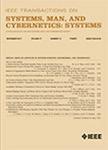版权所有:内蒙古大学图书馆 技术提供:维普资讯• 智图
内蒙古自治区呼和浩特市赛罕区大学西街235号 邮编: 010021

作者机构:Huazhong Univ Sci & Technol Sch Automat Wuhan 430074 Peoples R China Educ Minist China Key Lab Image Proc & Intelligent Control Wuhan 430074 Peoples R China Wuhan Univ Sch Math & Stat Wuhan 430072 Peoples R China City Univ Hong Kong Dept Elect Engn Hong Kong Peoples R China
出 版 物:《IEEE TRANSACTIONS ON SYSTEMS MAN CYBERNETICS-SYSTEMS》 (IEEE Trans. Syst. Man Cybern. Syst.)
年 卷 期:2021年第51卷第2期
页 面:786-796页
核心收录:
学科分类:0808[工学-电气工程] 08[工学] 0811[工学-控制科学与工程] 0812[工学-计算机科学与技术(可授工学、理学学位)]
基 金:National Natural Science Foundation of China [61773175, 61702377] Natural Science Foundation of Hubei Province [2017CFB426] Hong Kong Research Grants Council through GRF [CityU 11234916]
主 题:Complex dynamical network grounded Laplacian matrix pinning control spectral properties
摘 要:Pinning control of a complex network aims at forcing the states of all nodes to track an external signal by controlling a small number of nodes in the network. In this paper, an algebraic graph-theoretic condition is introduced to optimize pinning control. When individual node dynamics and coupling strength of the network are given, the effectiveness of pinning scheme can be measured by the smallest eigenvalue of the grounded Laplacian matrix obtained by deleting the rows and columns corresponding to the pinned nodes from the Laplacian matrix of the network. The larger this smallest eigenvalue, the more effective the pinning scheme. Spectral properties of the smallest eigenvalue are analyzed using the network topology information, including the spectrum of the network Laplacian matrix, the minimal degree of uncontrolled nodes, the number of edges between the controlled node set and the uncontrolled node set, etc. The identified properties are shown effective for optimizing the pinning control strategy, as demonstrated by illustrative examples. Finally, for both scale-free and small-world networks, in order to maximize their corresponding smallest eigenvalues, it is better to pin the nodes with large degrees when the percentage of pinned nodes is relatively small, while it is better to pin nodes with small degrees when the percentage is relatively large. This surprising phenomenon can be explained by one of the theorems established.